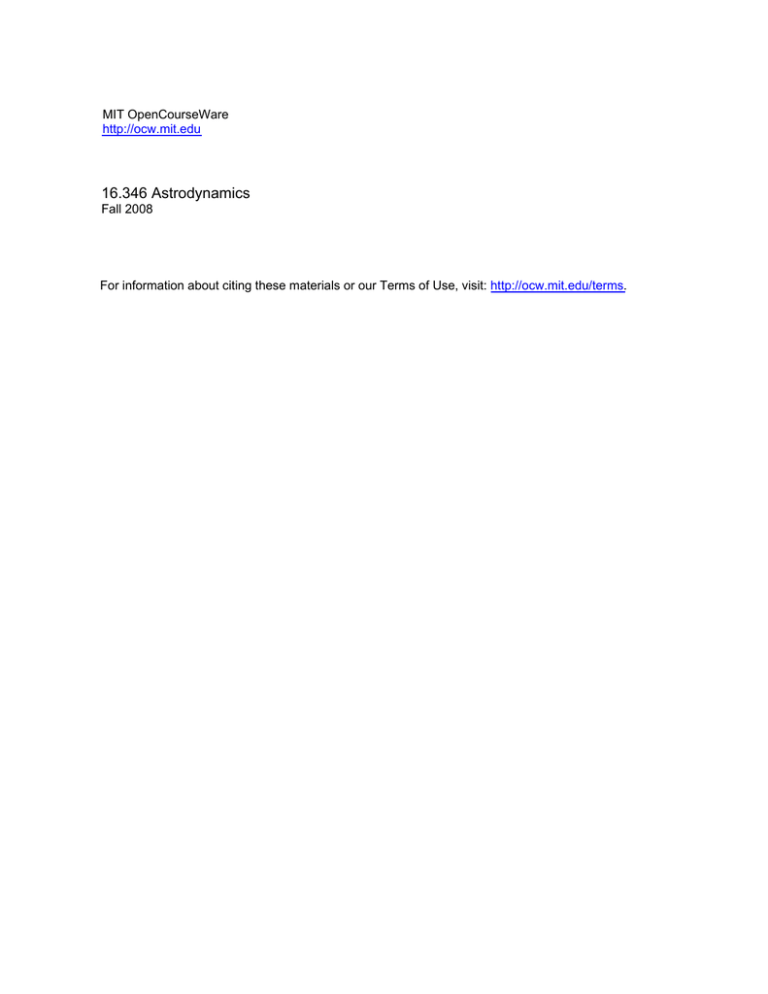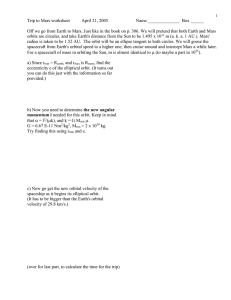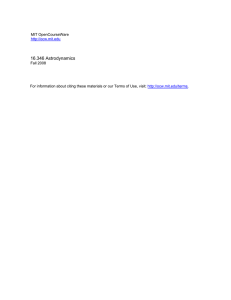16.346 Astrodynamics MIT OpenCourseWare .
advertisement

MIT OpenCourseWare http://ocw.mit.edu 16.346 Astrodynamics Fall 2008 For information about citing these materials or our Terms of Use, visit: http://ocw.mit.edu/terms. Exercises 12 1. Find the passing distances at Venus and Mars for the two multiple flybys orbits. 2. Consider a spacecraft launched from earth on a fly-by mission to Jupiter. The semi­ major axis of the solar orbit is 3.2 astronomical units and the transfer angle to Jupiter is 170 ◦ . a. What would be the aphelion radius of the spacecraft orbit if there were no Jovian contact? b. Assume the spacecraft passes behind Jupiter at an altitude of 950,000 miles above the planet surface. (Assume the radius of the planet Jupiter to be 44,350 miles.) Now, what would be the aphelion radius of the spacecraft orbit after contact with Jupiter? In particular, could the spacecraft rendezvous with Saturn if the timing were right? How about Uranus and/or Neptune? c. How close to the surface of the planet Jupiter would the spacecraft have to pass in order to escape from the Solar System? d. Determine the travel time from earth to Jupiter. e. What is the speed of the spacecraft relative to the earth after departure, i.e., what is the v∞ in feet per second? Note: For simplicity, assume all planetary orbits are coplanar and circular. Mars Reconnaissance Orbiter Continued 1. Calculate the minimum impulse ∆v using only the Q coefficient, i.e., assuming the Earth to move in a circular orbit. Compare the result obtained by using both P and Q with no assumption made for the initial orbit. 2. Assuming that the MRO is injected from a 100 mile altitude circular parking orbit, calculate the initial position and velocity of the hyperbolic orbit at perigee. 3. Compare the speed of the MRO, as it crosses the earth’s sphere of influence, to the ultimate asymptotic speed of the escape hyperbola. 4. Find the time required to reach the earth’s sphere of influence. 5. Calculate the velocity vector of the spacecraft and the velocity vector of Mars at the time of arrival. The relative velocity is difference of these two velocities. Find the hyperbolic trajectory within the Martian sphere of influence which has its pericenter at Mars at an altitude of 100 miles. 6. Determine the ∆v to place the spacecraft in an orbit of Mars. Compare the velocity required for a circular orbit and one with eccentricity e = 0.7. 7. Find the time to travel to the pericenter of the hyperbola inside of the Martian sphere of influence. Note: The sphere of influence of Mars is 357,000 miles and the radius of the planet is 2,100 miles. The Mars/sun mass ratio is 3,0931,500 . 8. Use Gauss’ Method, developed in the following Lecture, to solve the MRO boundaryvalue problem. Specifically: Given the earth’s position vector at launch as P1 , the Mars position vector at arrival P2 and the flight-time t2 − t1 . Find the orbit, i.e., the orbital elements a and p . 9. Repeat this computation using the method of Battin and Vaughan given on Page 4 of Lecture 17.




